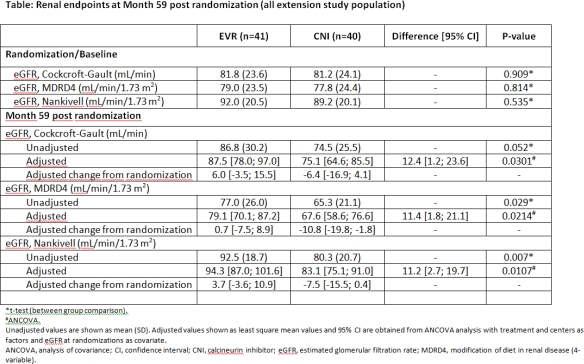Everolimus and Early Calcineurin Inhibitor Withdrawal Is Associated With Superior Renal Function: 5-Year Follow-Up of the Randomized PROTECT Liver Transplantation Study
PROTECT Study Group, Novartis Pharma GmbH, Germany.
Meeting: 2015 American Transplant Congress
Abstract number: 392
Keywords: Efficacy, Graft survival, Immunosuppression, Liver transplantation
Session Information
Session Name: Concurrent Session: Liver: Immunosuppression and Rejection
Session Type: Concurrent Session
Date: Tuesday, May 5, 2015
Session Time: 2:15pm-3:45pm
 Presentation Time: 2:27pm-2:39pm
Presentation Time: 2:27pm-2:39pm
Location: Room 120-ABC
Purpose: At the end of the 12-month (M) PROTECT core study (NCT00378014), de novo liver transplant recipients (LTxR) who switched from a calcineurin inhibitor (CNI) based immunosuppression to a CNI free everolimus (EVR) based regimen showed numerically better renal function. The renal function benefit with EVR group was maintained up to 3 years post LTx. Here we present the 5-year follow-up data from the PROTECT study. Methods: PROTECT was an open-label, parallel-group, randomized controlled study in which LTxR received basiliximab and CNI-based immunosuppression with/without corticosteroids. Between Week 4 and 8, patients were randomized 1:1 to receive EVR or continue CNI. In the EVR group, CNI was completely withdrawn after 8 weeks. Patients who completed core study were asked to enter the extension study and continue their randomized treatment. Key endpoints included change in renal function measured by estimated glomerular filtration rate (eGFR) by Cockcroft-Gault (CG), efficacy failure (composite of biopsy-proven acute rejection [BPAR], graft loss, death, or loss to follow-up), and incidence of adverse events (AEs) and serious AEs (SAEs). Results: A total of 81 patients entered the extension study (41, EVR group; 40, CNI group). At M59 post randomization, the adjusted mean eGFR was significantly higher in the EVR vs CNI group, with a benefit of 12.4 mL/min using CG [95%CI: 1.2; 23.6; P=0.0301]. In the extension period, 3 deaths occurred (EVR, 1; CNI, 2). There were no cases of graft loss. Two BPAR occurred in the EVR group. SAEs occurred in 26 (63.4%) and 28 (70.0%) of the patients in the EVR and CNI group, respectively. The most commonly reported AEs were incisional hernia, nasopharyngitis, peripheral edema, diarrhea, and back pain. Conclusion: In comparison to CNI based immunosuppressive treatment EVR-based CNI free immunosuppression resulted in better renal function and comparable patient and graft outcomes after 5 years follow-up.
To cite this abstract in AMA style:
Sterneck M, Kaiser G, Heyne N, Richter N, Rauchfuss F, Pascher A, Schemmer P, Fischer L, Klein C, Nadalin S, Lehner F, Settmacher U, Gotthardt D, Loss M, Ladenburger S, Wimmer P, Dworak M, Schlitt H. Everolimus and Early Calcineurin Inhibitor Withdrawal Is Associated With Superior Renal Function: 5-Year Follow-Up of the Randomized PROTECT Liver Transplantation Study [abstract]. Am J Transplant. 2015; 15 (suppl 3). https://atcmeetingabstracts.com/abstract/everolimus-and-early-calcineurin-inhibitor-withdrawal-is-associated-with-superior-renal-function-5-year-follow-up-of-the-randomized-protect-liver-transplantation-study/. Accessed July 18, 2025.« Back to 2015 American Transplant Congress
